Attracting Wild Birds to Your Garden
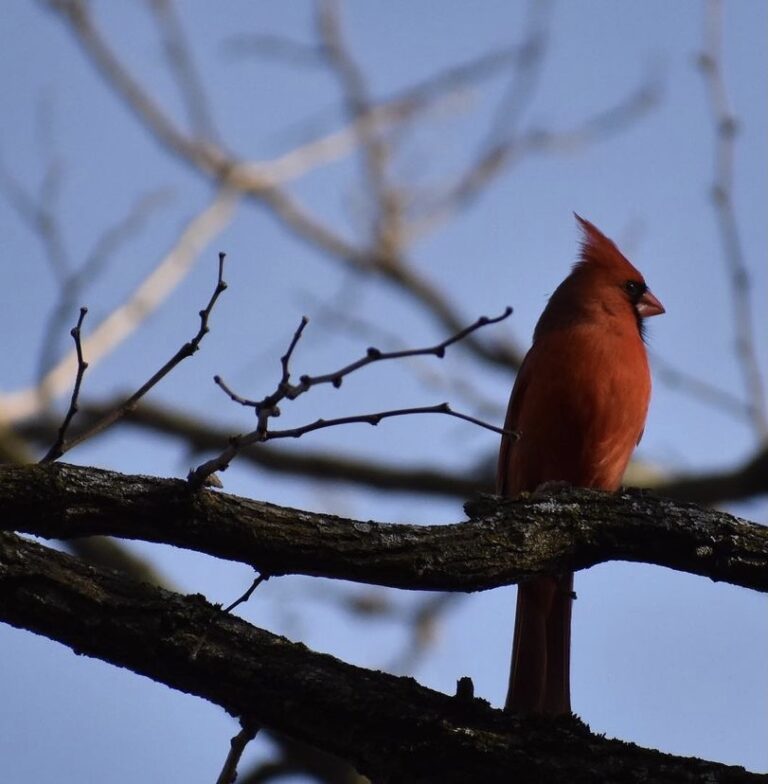
Birds, like flowers, have their seasons and growing preferences. They have evolved and adapted to particular environments and sometimes very specific ones. Providing native plants will most often attract the most variety of familiar birds, the native residents of our area.
The basics for attracting birds are:
- Consistent supply of food- each in its season- maybe just that week the bird is flying through
- Protective cover or nesting sites – at a safe distance from predator hiding places or access.
- Water for bathing and drinking – at a safe distance from predator hiding places or access.
- Dust areas for consuming grit and helping feather hygiene.
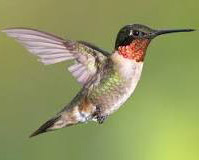
Ruby throated Hummingbirds will arrive in the Berkshires in early May and seek out nectar often as late as early October.
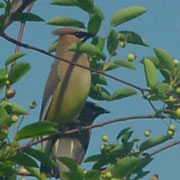
Two Cedar Waxwings hiding in a Serviceberry
When planning your garden, you might consider that common, familiar birds are not always year-round residents and some year-rounders change plumage, becoming unrecognizable in their ‘snow-suits’. Colorful hummingbirds, vireos, orioles and warblers migrate to our yards or further points north in Spring and return south each Fall. Some of these need to rest-up and re-charge on their way, returning each year briefly to your familiar clump of Serviceberry or for a lake’s annual emergence of May-flies. Consider plants that attract these transients as well as provide for local breeding pairs.
The Garden is Yours and the Birds. Like flowers some birds are more particular than others. Consider what birds you would like in your backyard then learn what their specific needs might be. A bluebird prefers an open field surrounding a nesting box or tree hollow at least 8’ off the ground. A box or hole in a wooded lot will be less appealing to bluebirds but just-right for chickadees. Consider your own needs as well. Your small lot in town may not lend itself to a large tangle of shrubs that appeal to warblers. This printable chart lists some familiar birds and their favored plants–as food sources and nesting choices. Or visit this part of the Audubon website listing native plants where you can key in your property zip code to see a list of native plants to your area along with the birds they attract!
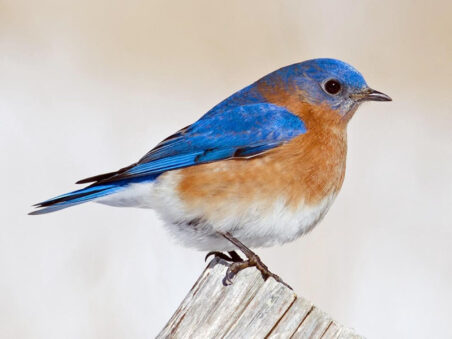
Suet feeders or dried meal worms on a tray feeder will attract bluebirds even if you can’t provide suitable nesting sites.
Maybe you can’t provide the nest site but you can offer meals. It may be impossible to provide everything a bird species requires on your property. For instance, it is unlikely orioles will visit you if tall trees for nesting are not available in the area. But if you have seen (or heard) an oriole on your property, the bird has probably found a suitable nest site nearby. You could encourage more visits by providing a consistent summer food source, flowering and fruiting trees for example.
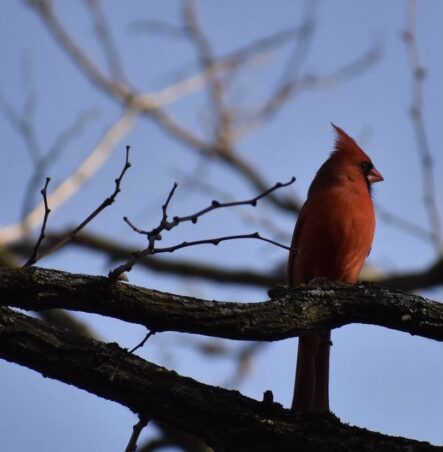
Cardinal male adult Photo: Eva Ward
Birds seek safety. Birds will seek protection for themselves and their young from predators and foul weather conditions. Needs may be very specific. Ground-frequenting birds like quail and sparrows seek the low cover of ornamental grasses and cotoneaster, while orioles and cardinals prefer the protective heights of thorny quinces and hawthorns, or upright junipers.
Provide quick escape protection a short flight away from birdbaths and feeders but not immediately adjacent. A house cat can hide under a shrub ready to pounce but can only pounce a few feet.
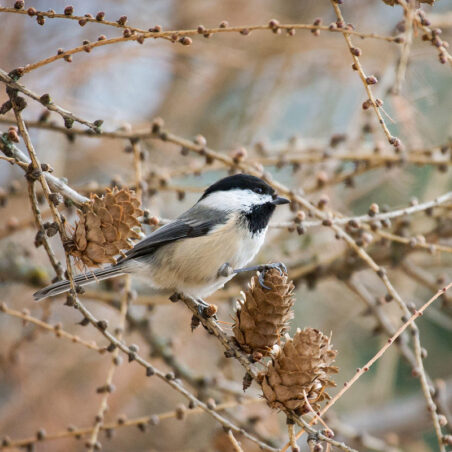
Black-capped Chickadee Photo: Joanie Christian, Great Backyard Bird Count, Audubon 2018
Food Sources
Winter months: Seed in a feeder– Loaded with oils and carbohydrates “wild bird seed” (especially sunflower seed) provides the high energy that birds need to survive the cold. See our feeders and seed choices. Also try planting large sunflowers in May; then, keep the enormous seed heads outdoors through fall and into winter to attract woodpeckers, cardinals, finches and chickadees.
Warm-weather months: Time for raising a family. Requirements may take the form of nectar, insects, fruits, berries and other succulent plant parts. These provide the higher protein and essential nutrients needed to breed and raise young. Food sources in the form of plant material will vary depending on the species of bird. Annuals, perennials, shrubs and trees can all be nectar producing plants that attract hummingbirds for example. Again, check this printable chart
Nesting sites.
Some prefer cavities and adapt well to birdhouses, while others prefer nesting on the ground, in communities, or in the branches of trees at various heights. Study the birds you want to attract to determine what might best be provided for nesting sites. The National Audubon Society Field Guide to Birds, Eastern Region has specific notes on each bird’s preferences. Or visit the Audubon website online. Note that most birds use plant material in building their nests. Entice more birds to your property with ornamental grasses, shredding bark, dried stems, etc. because all are potential fibers used in nest building.
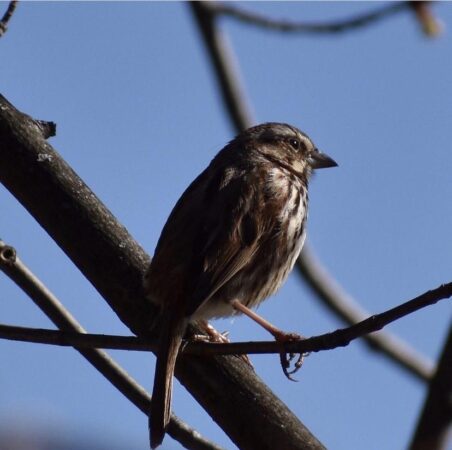
Song Sparrow Photo: Eva Ward
Leaf litter
Consider providing a portion of your landscape where leaves remain undisturbed through winter until late spring for ground foragers. The ‘leaf litter’ shelters insects in the fall, winter and spring. Often you will see sparrows, titmice, juncos or robins “playfully” turning over leaves in search of a succulent snack.
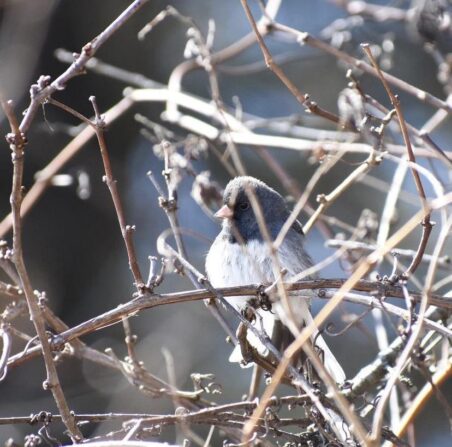
Junco male adult Photo: Eva Ward
Water
A source for clean drinking water is essential for birds of all species. There may be a natural source near your property or you may decide to provide in the form of a birdbath, or even better, a water garden. Heaters are available to keep birdbaths ‘open’ all winter as well.
Dust Baths
After feeding, feather maintenance occupies much of a bird’s time. Dust bathing, is a routine pastime for many bird species and seems to clear mites and parasites. Provide an area not less than 3 square feet and approximately 6” deep with an equal mixture of sand, loam and sifted wood ash. Dust baths can be edged with brick, stone or wood to improve their appearance.
The sand in dust bath mixes is a wonderful source of grit needed for digestion of food in birds.
Our Summer Garden Advice
By mid-summer, perennial gardens can start to look overgrown, annual flowers begin to fade, and bugs may be munching on your vegetables.
Summer Articles